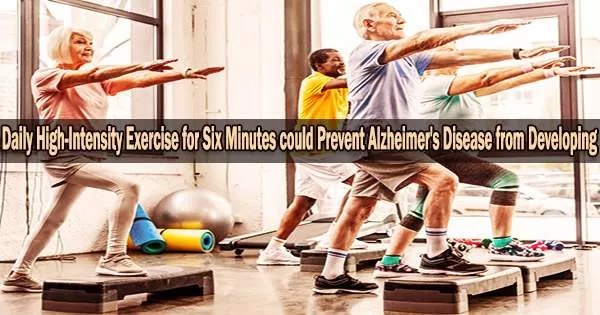There is evidence that regular exercise, including high-intensity exercise, may be beneficial for cognitive health and may potentially delay the onset of Alzheimer’s disease. Studies have shown that physical activity can improve brain function, increase blood flow to the brain, and promote the growth of new brain cells.
High-intensity exercise for six minutes could increase the longevity of a healthy brain and postpone the beginning of neurodegenerative diseases like Parkinson’s and Alzheimer’s.
A brief but vigorous cycling session promotes the production of a specific protein that is crucial for brain development, learning, and memory and may shield the brain from age-related cognitive decline, according to new research published in The Journal of Physiology. This understanding of exercise is a component of the effort to create non-pharmacological treatments that are universally affordable, accessible, and effective in promoting healthy aging.
The specialized protein named brain-derived neurotrophic factor (BDNF) promotes neuroplasticity (the ability of the brain to form new connections and pathways) and the survival of neurons.
According to research conducted on animals, BDNF availability increases memory formation and storage, improves learning, and generally improves cognitive performance. These key roles and its apparent neuroprotective qualities have led to the interest in BDNF for aging research.
Lead author Travis Gibbons from University of Otago, New Zealand stated, “BDNF has shown great promise in animal models, but pharmaceutical interventions have thus far failed to safely harness the protective power of BDNF in humans. We saw the need to explore non-pharmacological approaches that can preserve the brain’s capacity which humans can use to naturally increase BDNF to help with healthy aging.”
To tease apart the influence of fasting and exercise on BDNF production, the researchers, from the University of Otago, New Zealand, compared the following factors to study the isolated and interactive effects:
- Fasting for 20 hours
- Light exercise (90-minute low intensity cycling)
- High-intensity exercise (six-minute bout of vigorous cycling)
- Combined fasting and exercise
In comparison to one day of fasting with or without a lengthy session of gentle activity, they discovered that brief but vigorous exercise was the most effective approach to enhance BDNF. BDNF increased by four to five-fold (396 pg L-1 to 1170 pg L-1) more compared to fasting (no change in BDNF concentration) or prolonged activity (slight increase in BDNF concentration, 336 pg L-1 to 390 pg L-1).
More research is required to fully understand the mechanisms at play because the reason for these discrepancies is still unknown. One theory relates to glucose metabolism, the brain’s main fuel source, and the cerebral substrate switch.
The cerebral substrate switch occurs when the brain moves from one preferred fuel source to another in order to meet the body’s energy requirements, such as when lactate is metabolized during exercise instead of glucose. The brain’s transition from consuming glucose to lactate initiates pathways that result in elevated levels of BDNF in the blood.
Exercise has been shown to raise BDNF levels, which may be explained by an increase in platelets, the smallest blood cell and a major reservoir of BDNF. Exercise exerts a 20% greater influence on the concentration of platelets in the blood than does fasting.
Twelve physically active participants (six males, six females aged between 18 and 56 years) took part in the study. Instead of showing sex disparities, the evenly split between male and female participants was intended to better represent the population.
In order to distinguish between the influence on BDNF and the cognitive benefits, more study is being done to go deeper into the effects of calorie restriction and exercise.
Travis Gibbons noted, “We are now studying how fasting for longer durations, for example up to three days, influences BDNF. We are curious whether exercising hard at the start of a fast accelerates the beneficial effects of fasting. Fasting and exercise are rarely studied together. We think fasting and exercise can be used in conjunction to optimize BDNF production in the human brain.”
However, it is important to note that more research is needed to fully understand the relationship between exercise and Alzheimer’s disease, and six minutes of daily high-intensity exercise is not a definitive or guaranteed prevention method. Additionally, it is important to consult with a healthcare professional before starting any new exercise regimen.
















